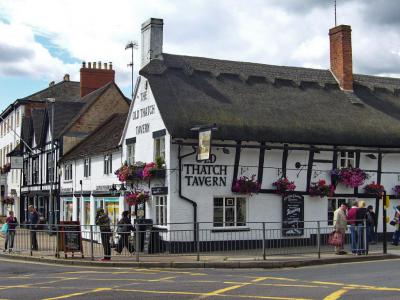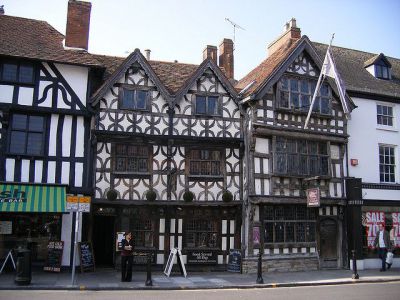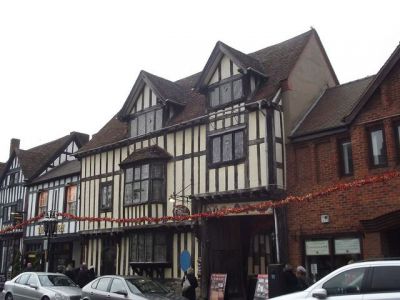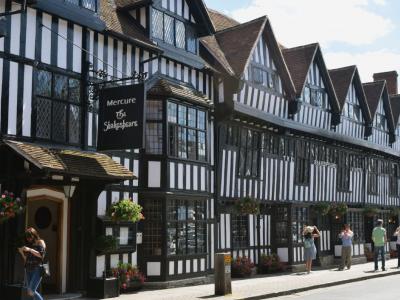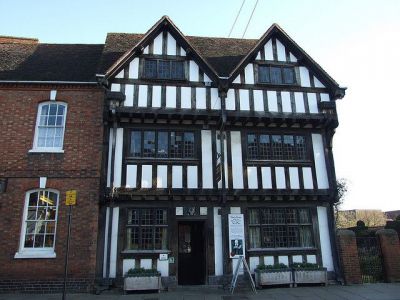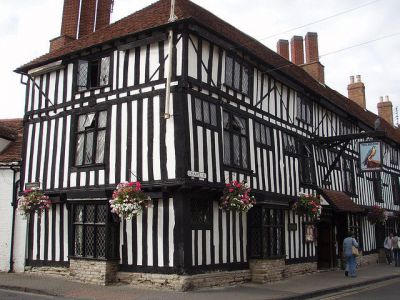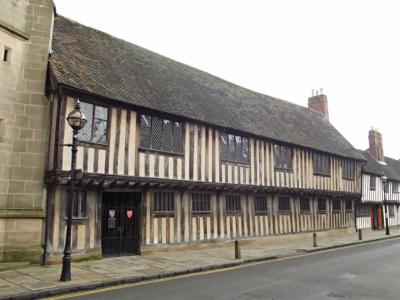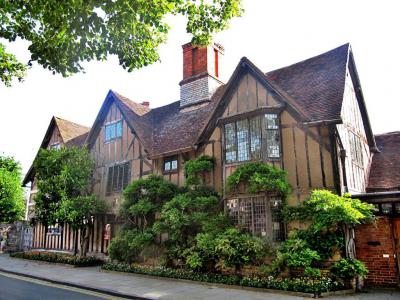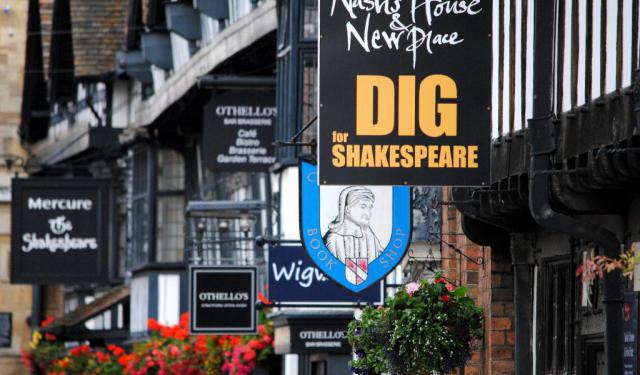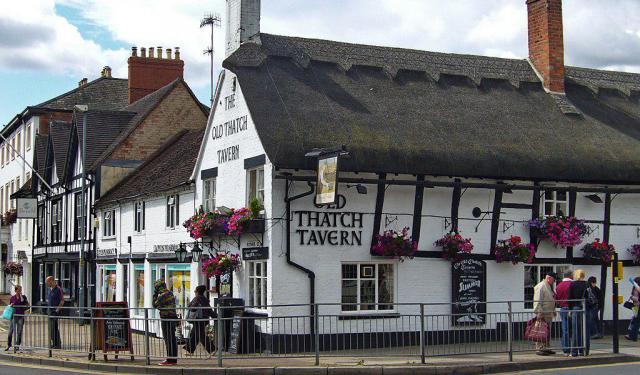Historical Tudor Houses Walking Tour (Self Guided), Stratford-upon-Avon
The first thing that strikes one walking across the medieval center of Stratford-Upon-Avon is the abundance of timber-framed Tudor houses. Their most notable feature, often combined with an overhanging upper story, is an exposed wooden framework; the rest is typically filled with brick, plaster or wattle-and-daub.
Many of these buildings have been kept in their original state, notably the classic black-and-white appearance, since the 16th century. And as it is Shakespeare's hometown, there are quite a few properties closely associated with the Bard himself.
Here are some of the most notable examples of Tudor architecture in Stratford:
Old Thatch Tavern – a visible landmark and the oldest pub in town, licensed since 1623.
Tudor World – the oldest lived-in house in Stratford, once owned by William Rogers, the real-life person who inspired Shakespeare's comic Falstaff character; nowadays an award-winning Tudor museum.
Shakespeare Hotel – a 16th century gabled building carefully preserved in its original state.
Nash House – the former dwelling of William Shakespeare's granddaughter, Elizabeth Hall; named after her first husband and original owner of the property, Thomas Nash.
Falcon Hotel – a quintessentially Tudor, half-timbered inn; carefully restored.
Hall's Croft – named after the physician Dr John Hall who married William Shakespeare's eldest daughter, Susanna.
Stratford’s ancient Tudor buildings bring history to life. If you wish to step in the shoes of the great Bard and view the same stonework as Shakespeare himself might have gazed upon while composing his immortal plays, take this self-guided walk!
Many of these buildings have been kept in their original state, notably the classic black-and-white appearance, since the 16th century. And as it is Shakespeare's hometown, there are quite a few properties closely associated with the Bard himself.
Here are some of the most notable examples of Tudor architecture in Stratford:
Old Thatch Tavern – a visible landmark and the oldest pub in town, licensed since 1623.
Tudor World – the oldest lived-in house in Stratford, once owned by William Rogers, the real-life person who inspired Shakespeare's comic Falstaff character; nowadays an award-winning Tudor museum.
Shakespeare Hotel – a 16th century gabled building carefully preserved in its original state.
Nash House – the former dwelling of William Shakespeare's granddaughter, Elizabeth Hall; named after her first husband and original owner of the property, Thomas Nash.
Falcon Hotel – a quintessentially Tudor, half-timbered inn; carefully restored.
Hall's Croft – named after the physician Dr John Hall who married William Shakespeare's eldest daughter, Susanna.
Stratford’s ancient Tudor buildings bring history to life. If you wish to step in the shoes of the great Bard and view the same stonework as Shakespeare himself might have gazed upon while composing his immortal plays, take this self-guided walk!
How it works: Download the app "GPSmyCity: Walks in 1K+ Cities" from Apple App Store or Google Play Store to your mobile phone or tablet. The app turns your mobile device into a personal tour guide and its built-in GPS navigation functions guide you from one tour stop to next. The app works offline, so no data plan is needed when traveling abroad.
Historical Tudor Houses Walking Tour Map
Guide Name: Historical Tudor Houses Walking Tour
Guide Location: England » Stratford-upon-Avon (See other walking tours in Stratford-upon-Avon)
Guide Type: Self-guided Walking Tour (Sightseeing)
# of Attractions: 8
Tour Duration: 1 Hour(s)
Travel Distance: 1.1 Km or 0.7 Miles
Author: DanaOffice
Sight(s) Featured in This Guide:
Guide Location: England » Stratford-upon-Avon (See other walking tours in Stratford-upon-Avon)
Guide Type: Self-guided Walking Tour (Sightseeing)
# of Attractions: 8
Tour Duration: 1 Hour(s)
Travel Distance: 1.1 Km or 0.7 Miles
Author: DanaOffice
Sight(s) Featured in This Guide:
- Old Thatch Tavern
- Harvard House and Garrick Inn
- Tudor World
- Shakespeare Hotel
- Nash House
- Falcon Hotel
- Shakespeare's Schoolroom and Guildhall
- Hall's Croft
1) Old Thatch Tavern
Housed in a traditional Tudor-style building with a timeless (over 500 years old!) thatched roof, the Old Thatch Tavern is a visible landmark of Stratford-upon-Avon.
The Old Thatch Tavern became an ale-house in 1470 and is possibly the oldest pub in town within the same building. The claim comes from its licensing date of 1623 – other local pubs possibly not had an official license until later.
Being the last remaining thatched-roof property in Stratford, the tavern has no difficulty attracting visitors with its well-maintained period décor and very English cuisine – quality homemade food based on as much local produce as possible. Added to their traditional menu is also a specials board which is changed on a weekly basis.
Another feature contributing to the rich tapestry of this historic location is a murky tale of murder on Christmas Day 1795. The spirit of the victim, Joseph Pinfield, is said to continue haunting the place to this very day…
For any of these reasons, perhaps you should pay a visit here too.
The Old Thatch Tavern became an ale-house in 1470 and is possibly the oldest pub in town within the same building. The claim comes from its licensing date of 1623 – other local pubs possibly not had an official license until later.
Being the last remaining thatched-roof property in Stratford, the tavern has no difficulty attracting visitors with its well-maintained period décor and very English cuisine – quality homemade food based on as much local produce as possible. Added to their traditional menu is also a specials board which is changed on a weekly basis.
Another feature contributing to the rich tapestry of this historic location is a murky tale of murder on Christmas Day 1795. The spirit of the victim, Joseph Pinfield, is said to continue haunting the place to this very day…
For any of these reasons, perhaps you should pay a visit here too.
2) Harvard House and Garrick Inn
Harvard House was built in 1596 by Thomas Rogers in classical Tudor style. Thomas was the grandfather of John Harvard, of Harvard University fame. Thomas and his second wife, Alice, carved their initials into the house front. Proof it was indeed their house. Thomas was a rich merchant. He served as Alderman for the Stratford Corporation, beside John Shakespeare.
In 1909 Marie Corelli, novelist, supported Edward Morris, an American in his efforts to purchase the house. Morris succeeded in buying the house. It was given to Harvard University and became known as Harvard House.
The missing link concerning the name Harvard is found in 1605 with the marriage of Thomas' daughter, Katherine to Robert Harvard. Robert and Katherine had a son in 1607 and his name became John. Flash ahead to 1636. John married Ann Sadler and they emigrated to Massachusetts. John was a preacher and a teacher. He died in 1636.
Before he died, the Massachusetts Bay Colony founded a college in Cambridge. John had bequeathed 750 pounds and his library of books to the college. In gratitude the college was named Harvard.
The Garrick Inn is located at 25 High Street in Stratford-upon-Avon, cheek and jowl to Harvard House. It is said to be the oldest pub in town, but the old Thatch Tavern contests that claim. The building is thought to have been erected in 1596 with parts of it going back to the 14th century.
It was once called the Greyhound, and/or The Reindeer. Then it was named after the actor David Garrick. It is claimed plague started in the original Inn, possibly when it was Greyhound or Reindeer, or not. The unlucky fellow who gets credit for the plague is one Oliver Gunn. Someone wrote "Here begins the plague" in Latin in his burial entry.
There have been rumors of ghosts. Was there ever an old pub without at least one?
In 1909 Marie Corelli, novelist, supported Edward Morris, an American in his efforts to purchase the house. Morris succeeded in buying the house. It was given to Harvard University and became known as Harvard House.
The missing link concerning the name Harvard is found in 1605 with the marriage of Thomas' daughter, Katherine to Robert Harvard. Robert and Katherine had a son in 1607 and his name became John. Flash ahead to 1636. John married Ann Sadler and they emigrated to Massachusetts. John was a preacher and a teacher. He died in 1636.
Before he died, the Massachusetts Bay Colony founded a college in Cambridge. John had bequeathed 750 pounds and his library of books to the college. In gratitude the college was named Harvard.
The Garrick Inn is located at 25 High Street in Stratford-upon-Avon, cheek and jowl to Harvard House. It is said to be the oldest pub in town, but the old Thatch Tavern contests that claim. The building is thought to have been erected in 1596 with parts of it going back to the 14th century.
It was once called the Greyhound, and/or The Reindeer. Then it was named after the actor David Garrick. It is claimed plague started in the original Inn, possibly when it was Greyhound or Reindeer, or not. The unlucky fellow who gets credit for the plague is one Oliver Gunn. Someone wrote "Here begins the plague" in Latin in his burial entry.
There have been rumors of ghosts. Was there ever an old pub without at least one?
3) Tudor World (must see)
Tudor World is a Museum of everyday life in the time of the Tudors. It is located on Sheep Street, Stratford-upon-Avon, almost exactly in the center of town. The museum operates several different tours including the Walking tour with William Shakespeare himself. William answers questions, tells stories and even poses for pictures.
And best of all for some people, is the Ghost tour. The Ghost tour takes place in the evenings, entirely within the confines of the haunted 12th century edifice. It is not recommended for children under 14. It is spooky and that's the best part. It is so spooky William Shakespeare will not take the tour himself (he said so).
Ghostly visions have been reported by some visitors but the management assures us there has never been an attack by a ghost. The management also guarantees there will not be an attack by anyone living. (Anyone LIVING, that is.) The tour relates the history of ghostly visitations in the building and around the town.
Visitors are taken through the Ghost tour by a guide with a lantern. In each room he/she will talk of the ghostly history of the place. The museum is over 400 years old. The rooms have low ceilings and beams and floors slightly warped. This type of thing is not recommended for those who are nervous or who have physical limitations.
For those who are not overly impressed with the Ghost tour, there will be a Halloween "Terror" tour. Be sure to come at Halloween. For the psychic fans there is a Victorian seance. A seance in a haunted house! Will William be there? He does not answer calls. Well, there's always fortune telling. That's even approved for kids.
Tips:
Take the virtual tour first.
And best of all for some people, is the Ghost tour. The Ghost tour takes place in the evenings, entirely within the confines of the haunted 12th century edifice. It is not recommended for children under 14. It is spooky and that's the best part. It is so spooky William Shakespeare will not take the tour himself (he said so).
Ghostly visions have been reported by some visitors but the management assures us there has never been an attack by a ghost. The management also guarantees there will not be an attack by anyone living. (Anyone LIVING, that is.) The tour relates the history of ghostly visitations in the building and around the town.
Visitors are taken through the Ghost tour by a guide with a lantern. In each room he/she will talk of the ghostly history of the place. The museum is over 400 years old. The rooms have low ceilings and beams and floors slightly warped. This type of thing is not recommended for those who are nervous or who have physical limitations.
For those who are not overly impressed with the Ghost tour, there will be a Halloween "Terror" tour. Be sure to come at Halloween. For the psychic fans there is a Victorian seance. A seance in a haunted house! Will William be there? He does not answer calls. Well, there's always fortune telling. That's even approved for kids.
Tips:
Take the virtual tour first.
4) Shakespeare Hotel
Partially sited in one of the oldest (14th-century) and most attractive half-timbered buildings in Stratford-upon-Avon, the charming Shakespeare Hotel has long been a meeting place of writers, actors and artists in the heart of Shakespeare Country.
The hotel itself was established in the 16th century and changed its name to ‘The Shakespeare’ only in the 18th century – the first recorded exploitation of the Bard’s name for tourist purposes.
As an object of national architectural and historical interest, this gabled inn has been preserved in its original state, thanks to a careful effort. Historic character prevails here everywhere, be it on the traditionally painted black-and-white façade and all the street frontage, or the low-beamed ceilings, huge stone fireplaces and enchantingly creaky floorboards on the inside.
The picturesque 4-star hotel offers 78 contemporary guestrooms, many of which are named after the plays and characters of William Shakespeare. The Bard himself (or rather the bust thereof) greets the arriving guests at the reception.
The historic inn is as alluring in winter as it is in summer. On a cold, damp day, catch the sight of The Quill lounge, with its vast fireplace, cosy armchairs and oil paintings on the wall, and you may well find yourself inside before you even know it, sipping afternoon tea.
The hotel itself was established in the 16th century and changed its name to ‘The Shakespeare’ only in the 18th century – the first recorded exploitation of the Bard’s name for tourist purposes.
As an object of national architectural and historical interest, this gabled inn has been preserved in its original state, thanks to a careful effort. Historic character prevails here everywhere, be it on the traditionally painted black-and-white façade and all the street frontage, or the low-beamed ceilings, huge stone fireplaces and enchantingly creaky floorboards on the inside.
The picturesque 4-star hotel offers 78 contemporary guestrooms, many of which are named after the plays and characters of William Shakespeare. The Bard himself (or rather the bust thereof) greets the arriving guests at the reception.
The historic inn is as alluring in winter as it is in summer. On a cold, damp day, catch the sight of The Quill lounge, with its vast fireplace, cosy armchairs and oil paintings on the wall, and you may well find yourself inside before you even know it, sipping afternoon tea.
5) Nash House
Standing right next door to the ruins and gardens of New Place, the residence in which William Shakespeare spent his last living days, is Nash's House.
This classical Tudor-period dwelling was built around 1500 and was once owned and occupied by Thomas Nash, a distinguished lawyer. In 1626 he married Shakespeare’s granddaughter Elizabeth – the only daughter of Susanna Shakespeare. In 1637, Susanna bought the property and later bequeathed it to Elizabeth. After Nash’s death in 1647, it was reserved for their use and that of their heirs.
When Elizabeth died childless in 1670, the direct line of Shakespeare came to an end and the property came into the possession of her second husband John Bernard. In 1876, The Shakespeare Birthplace Trust acquired both New Place and Nash's House, and converted the latter into a museum of local history.
The museum traces lineage from the earliest settlers in the Avon Valley to the time of Shakespeare, and has a permanent exhibition on the life of Shakespeare as a father, husband, and resident of Stratford, as well as his writing career.
A fine example of 16th-century architecture, the house features period furnishing (many fine pieces of original Jacobean, Tudor and Elizabethan furniture), tapestries and engravings, and boasts a first-floor viewing platform overlooking the New Place site, the Guild Chapel and King Edward VI School, where Shakespeare was a student.
Exhibits inside include the executor's copy of Shakespeare's will, dated 1616, and a copy of the “fine” (a Tudor term for legal action) marking Shakespeare's purchase of New Place. One of the most intriguing objects on display is a gold signet ring with the inscription 'WS' – discovered near Holy Trinity Church, where Shakespeare's daughter Judith was married in February 1616.
This classical Tudor-period dwelling was built around 1500 and was once owned and occupied by Thomas Nash, a distinguished lawyer. In 1626 he married Shakespeare’s granddaughter Elizabeth – the only daughter of Susanna Shakespeare. In 1637, Susanna bought the property and later bequeathed it to Elizabeth. After Nash’s death in 1647, it was reserved for their use and that of their heirs.
When Elizabeth died childless in 1670, the direct line of Shakespeare came to an end and the property came into the possession of her second husband John Bernard. In 1876, The Shakespeare Birthplace Trust acquired both New Place and Nash's House, and converted the latter into a museum of local history.
The museum traces lineage from the earliest settlers in the Avon Valley to the time of Shakespeare, and has a permanent exhibition on the life of Shakespeare as a father, husband, and resident of Stratford, as well as his writing career.
A fine example of 16th-century architecture, the house features period furnishing (many fine pieces of original Jacobean, Tudor and Elizabethan furniture), tapestries and engravings, and boasts a first-floor viewing platform overlooking the New Place site, the Guild Chapel and King Edward VI School, where Shakespeare was a student.
Exhibits inside include the executor's copy of Shakespeare's will, dated 1616, and a copy of the “fine” (a Tudor term for legal action) marking Shakespeare's purchase of New Place. One of the most intriguing objects on display is a gold signet ring with the inscription 'WS' – discovered near Holy Trinity Church, where Shakespeare's daughter Judith was married in February 1616.
6) Falcon Hotel
After a year-long extensive and quite impressive restoration, the former Falcon Hotel once again opened its doors to the public in 2019, re-branded as the Hotel Indigo.
This quintessentially Tudor, half-timbered property was built around 1500. Originally it had been a two-story town house (the third floor was added circa 1645) and had taken on many forms, including several as private dwellings, for another 150 years before it was turned into a hostelry. The first record of an inn on this location dates back to 1655.
The Royal Shakespeare Club is known to have held their annual dinners at The Falcon since 1824.
The multi-million pound project saw the stunning Warwickshire hotel meticulously restored with an utmost care being paid to the historic elements, such as the traditional black-and-white, close studded timber-frame and plaster façade. Because it's a listed building, like had to be replaced with like, and everything that could be kept has been, including many of the original oak beams from 1622.
The hotel's 93 guest rooms are designed on three themes: the Georgian, the Tudor, and the contemporary. In keeping with the theme, the Tudor rooms feature the authentic architectural quirks of the original 16th-century property and offer views over the site of Shakespeare’s New Place.
This quintessentially Tudor, half-timbered property was built around 1500. Originally it had been a two-story town house (the third floor was added circa 1645) and had taken on many forms, including several as private dwellings, for another 150 years before it was turned into a hostelry. The first record of an inn on this location dates back to 1655.
The Royal Shakespeare Club is known to have held their annual dinners at The Falcon since 1824.
The multi-million pound project saw the stunning Warwickshire hotel meticulously restored with an utmost care being paid to the historic elements, such as the traditional black-and-white, close studded timber-frame and plaster façade. Because it's a listed building, like had to be replaced with like, and everything that could be kept has been, including many of the original oak beams from 1622.
The hotel's 93 guest rooms are designed on three themes: the Georgian, the Tudor, and the contemporary. In keeping with the theme, the Tudor rooms feature the authentic architectural quirks of the original 16th-century property and offer views over the site of Shakespeare’s New Place.
7) Shakespeare's Schoolroom and Guildhall (must see)
Here is an interactive peek into William Shakespeare's childhood and schooling in the 16th century. The Guild of the Holy Cross built the Guildhall in 1420. Over the years more buildings were added, including a schoolhouse, a Chapel and Almshouses. The Guildhall was the headquarter of the Stratford Borough Council from 1553 and 1848.
When the Borough Council left for new digs at the Town Hall, they left the building to the school. The school, known as The King's New school, had been in the Guildhall since 1568. It later became the King Edward VI School (K.E.S.). Three years later seven-year-old William Shakespeare attended his first class. One may assume it was writing.
The school has been in continuous use by the local people since it first opened. The Guildhall has always been used and looked after and never neglected. Not only local students may study here, the school is also open to tourists. They may take an interactive class with William Shakespeare's teacher, Master Thomas Jenkins.
Adjoining the Guildhall is the Armoury. It was originally used a store place for arms, but after 1553 it became an administration center for the school. It also served as courtroom. On the first floor is the Master's chamber. In the center of the chamber is the prefect's table, bearing the names and initials of schoolboys through the years.
Students were mostly the children of wealthy middle class people. Williams' father, for instance, was the bailiff for the town. It was a public school and an entrance exam was required. Students did not pay fees, but they did have to provide their own firewood and candles. Classes frequently went from 6 am to 6 pm. There was a brief midday break.
Why You Should Visit:
to experience a bit how education used to be.
Tips:
When using the feather quill, be wary of ink blots.
When the Borough Council left for new digs at the Town Hall, they left the building to the school. The school, known as The King's New school, had been in the Guildhall since 1568. It later became the King Edward VI School (K.E.S.). Three years later seven-year-old William Shakespeare attended his first class. One may assume it was writing.
The school has been in continuous use by the local people since it first opened. The Guildhall has always been used and looked after and never neglected. Not only local students may study here, the school is also open to tourists. They may take an interactive class with William Shakespeare's teacher, Master Thomas Jenkins.
Adjoining the Guildhall is the Armoury. It was originally used a store place for arms, but after 1553 it became an administration center for the school. It also served as courtroom. On the first floor is the Master's chamber. In the center of the chamber is the prefect's table, bearing the names and initials of schoolboys through the years.
Students were mostly the children of wealthy middle class people. Williams' father, for instance, was the bailiff for the town. It was a public school and an entrance exam was required. Students did not pay fees, but they did have to provide their own firewood and candles. Classes frequently went from 6 am to 6 pm. There was a brief midday break.
Why You Should Visit:
to experience a bit how education used to be.
Tips:
When using the feather quill, be wary of ink blots.
8) Hall's Croft (must see)
Nearby to New Place was the house that William Shakespeare never lived in. Hall's Croft was the home of Susanna Shakespeare, William Shakespeare's daughter, and her husband, Doctor John Hall. Like New Place, Susanna's house had a flagstone floor. A stone floor was a sign of status. Most houses had earthen floors. The Halls were wealthy and they didn't mind showing it.
They owned fine furniture, heavy and strong, hand made from oak and very expensive. When Patients and other visitors entered the house, they understood the homeowner was someone to be respected. An enormous amount of work has been done on the house. The furniture appears authentic. But none of the original furniture remains.
The home contains a fine collection of 16th and 17th paintings. Doctor Hall is represented by his medical paraphernalia. Interesting to compare Jacobean medical practices to modern science. In the back of the house is a walled garden. The garden is maintained and it holds herbs and plants Doctor Hall might have used in his practice.
They owned fine furniture, heavy and strong, hand made from oak and very expensive. When Patients and other visitors entered the house, they understood the homeowner was someone to be respected. An enormous amount of work has been done on the house. The furniture appears authentic. But none of the original furniture remains.
The home contains a fine collection of 16th and 17th paintings. Doctor Hall is represented by his medical paraphernalia. Interesting to compare Jacobean medical practices to modern science. In the back of the house is a walled garden. The garden is maintained and it holds herbs and plants Doctor Hall might have used in his practice.
Walking Tours in Stratford-upon-Avon, England
Create Your Own Walk in Stratford-upon-Avon
Creating your own self-guided walk in Stratford-upon-Avon is easy and fun. Choose the city attractions that you want to see and a walk route map will be created just for you. You can even set your hotel as the start point of the walk.
William Shakespeare Walking Tour
The picturesque town of Stratford-upon-Avon is steeped in the history of William Shakespeare. Indeed, Shakespeare's hometown is where he was born and also where he passed away on the same day (23 April) 52 years later.
Many period locations in town, related to his and his family's life, are preserved as Britain's national heritage and visited by millions of people every year in a... view more
Tour Duration: 1 Hour(s)
Travel Distance: 1.4 Km or 0.9 Miles
Many period locations in town, related to his and his family's life, are preserved as Britain's national heritage and visited by millions of people every year in a... view more
Tour Duration: 1 Hour(s)
Travel Distance: 1.4 Km or 0.9 Miles
Stratford-upon-Avon Introduction Walking Tour
"Strat" is an Old English term derived from the Latin "Stratum", the word for street. A "ford" is a section of a stream where a crossing may be made. "Avon" is Celtic for river. Put them all together with links like a sausage and you have Stratford-upon-Avon. The ford actually exists. It is now marked by Clopton Bridge.
Primal Stratford was established by... view more
Tour Duration: 1 Hour(s)
Travel Distance: 1.9 Km or 1.2 Miles
Primal Stratford was established by... view more
Tour Duration: 1 Hour(s)
Travel Distance: 1.9 Km or 1.2 Miles
The Most Popular Cities
/ view all



